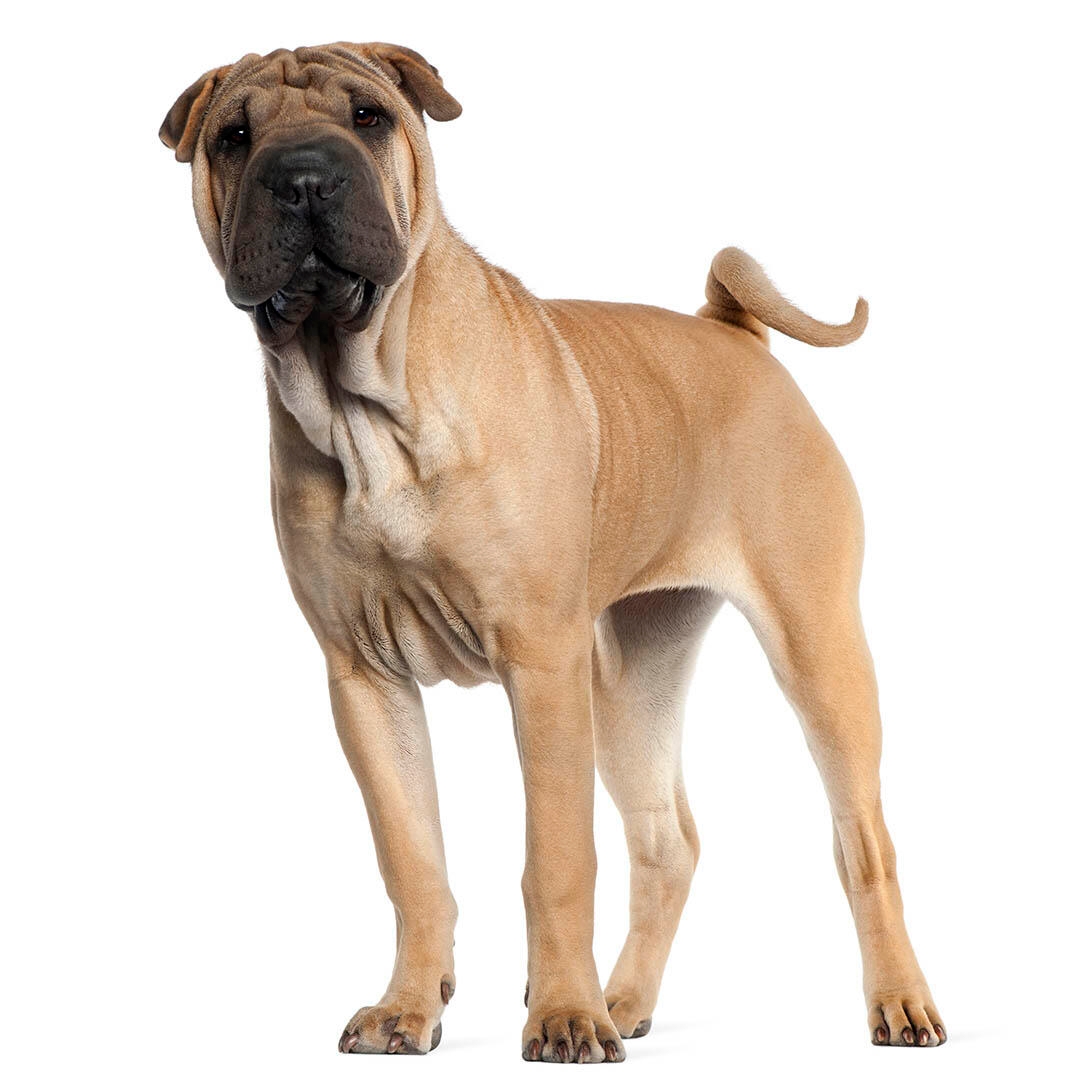
| Family-friendly: | 2/5 |
| Exercise needs: | 3/5 |
| Easy to train: | 3/5 |
| Tolerates being alone: | 4/5 |
| Likes other pets: | 2/5 |
| Energy level: | 2/5 |
| Grooming needs: | 3/5 |
| Shedding: | 5/5 |
The Shar Pei breed are prone mainly to skin and ear infections due to their excessive skin folds.
The breed is also classed as brachycephalic; problems associated with the condition include;
- Brachycephalic obstructive airway syndrome: a condition in brachycephalic breeds (those with a short nose and squashed face) where breathing is obstructed and can lead to reduced ability to exercise, or even severe respiratory distress.
- Skin inflammation/infection: brachycephalic breeds have a short nose and a normal amount of facial tissue. This means there is often excess skin around their face which leads to skin folds. The skin inside these folds can become sore and infections are prone to develop.
- Eye ulcers: ulcers are painful erosions on the surface of the eye. They are more common in brachycephalic breeds due to their conformation, as their eyes tend to be more bulbous.
The breed are also prone to:
- Glaucoma which is a painful condition where the pressure in the eye builds up.
- Primary lens luxation which is a condition where the lens moves from it's normal position in the eye which will result in vision loss and can cause pain.
- Entropion/ectropion which is a painful eye condition where the eyelids roll inwards/outwards. Again this is due to the large amount of skin that the breed has.
- Familial Shar Pei Fever which is a disorder that causes a high temperature and joint swelling.
Priority Kennel Club health schemes and testing:
- Eye screening scheme
Well-socialised Shar Pei are devoted to their families. They are loyal and can be playful and active but more often are rather aloof and can also be stubborn and territorial if not trained properly when young. They are naturally suspicious of strangers. They will be fine with cats if they have been introduced to them when puppies, but there can be problems mixing with other dogs. They often hate the cold.
| Family-friendly: | 2/5 |
| Exercise needs: | 3/5 |
| Easy to train: | 3/5 |
| Tolerates being alone: | 4/5 |
| Likes other pets: | 2/5 |
| Energy level: | 2/5 |
| Grooming needs: | 3/5 |
| Shedding: | 5/5 |
The Shar Pei, also known as the Chinese Fighting Dog, is thought to be descended from the Han Dog, a ancient guarding breed that lived in China around 2000 years ago.
The Han Dog gave rise to two different breeds - one a heavier, more bulky dog which went on the become the Chow and a smaller wrinkled dog who became used for fighting who became the Shar Pei. Both have the same unique blue tongue showing their linked ancestry.
The wrinkled skin along with their bristly coat was an intentional characteristic to give them an advantage in fights as their opponent would find it hard to get a good grip on them or cause serious injury.
The fighting career of the Shar Pei ended when organisers were able to import larger stronger dogs, and the breed became virtually extinct when Communist leaders who felt owning dogs was a Western decadence, slaughtered any they could find.
By 1978, they found a place in the Guinness Book of World Records as the rarest dog in the world before a group of breed enthusiasts used the few that were left to recreate the breed. Now their numbers have risen and their future is secure - although responsible breeders are still working hard to breed for both temperament and health.
The Shar Pei will suit an owner who enjoys their unconventional looks and who likes their aloof nature.
Shar Pei’s will take as much or as little exercise as offered as long as they have access to free play, but they are often happiest spending time in the garden. As a guide, an adult dog should be offered an hour of exercise daily, though he will happily accept more. As Shar Pei’s are often not keen on interacting with other dogs, long walks on lead are often best, so an active owner is needed.
The Shar Pei doesn’t need a large home but will enjoy a good-sized garden. As he is not always a particularly dog social, he will do well in a more isolated environment without close canine neighbours.
The Shar Pei diet needs to have the right balance of all the main nutrient groups including a constant supply of fresh water. It's important to conduct regular body condition scores to ensure you keep your dog in ideal shape and remember to feed him at least twice daily and in accordance with the feeding guidelines of his particular food.
Some lines have very close-set tails and these must be inspected and cleaned to prevent infection. The eyes should also be inspected daily. The coat itself just needs a going over with a soft brush.
Shar Pei’s look on training as something very definitely beneath them and they are a challenge to train. At the very least they should be socialised with other dogs when they are puppies and trainer to walk on a lead and harness.
Shar Pei’s do not make for good family dogs as they are not a lover of games or disruption, and they prefer a quiet household.
While many dogs are traditionally thought of as being good with children, all dogs and children need to be taught to get on with and respect each other, and be safe together. Even so, dogs and young children should never be left alone together and adults should supervise all interactions between them.